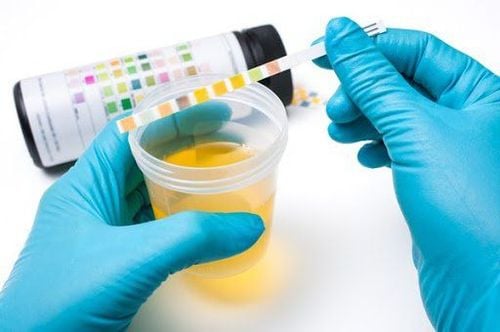This is an automatically translated article.
Posted by Master, Doctor Nguyen Nam Phong - Pediatrician - Department of Pediatrics - Neonatology - Vinmec Phu Quoc International General Hospital
Milk fangs are neonatal gingival cysts, this is a common benign lesion in the oral mucosa in a short period of time in infants, they usually cause few complications and most of them disappear on their own after a period of time. 2 weeks to 5 months after birth.
1. What is milk fang?
Milk fang or dnun is a common name in folklore to refer to one or more small white spots on the gums of an infant. Until now, many people still think this is a manifestation of excess calcium in children, or sometimes a milk residue due to poor oral hygiene or a dangerous disease.
The nature of milk fangs in babies is a type of fangs with thin shells filled with keratin. This is a degenerative product of keratinized epithelium. Milk fangs are usually white due to the remnants of cell debris during the formation of baby teeth left in the jawbone.
If appearing on the roof of the mouth, it may be due to debris of accessory salivary gland cells buried under the mucosa during fetal life.
Trắc nghiệm: các chỉ số cần chú ý về sự phát triển thể chất của trẻ
Chiều cao, cân nặng của bé ở từng giai đoạn nên là bao nhiêu là bình thường, bao nhiêu là bất thường? Cùng ThS.BS Ma Văn Thấm điểm lại xem bạn đã nắm được các chỉ số phát triển thể chất của bé chưa nhé!The following content is prepared under supervision of Thạc sĩ, Bác sĩ y khoa, Ma Văn Thấm , Nhi , Phòng khám Đa khoa Quốc tế Vinmec Dương Đông(Phú Quốc)
2. Can milk fangs cause danger?
Milk fangs are a common benign lesion of the oral mucosa of a short duration in infants. Milk fangs are common in infants aged 0 - 3 months, in some cases later, but rarely over 8 months of age, and it occurs in more than half of newborns. However, the actual rate may be even higher because this is a benign lesion, appearing for a short time, rarely causing pain to the child and often spontaneously breaking and disappearing in about 2 weeks, so they are often overlooked in medical facilities. Enlarged cysts can persist for up to 5 months without complications.

3. Should milk fangs be given to children?
When a child has been diagnosed with milk fangs, parents should not be too worried. First, it is necessary to evaluate whether the milk fangs cause any discomfort to the child, whether the child is fussy, feverish, or not. If there are no signs above, just clean your child's teeth very well and monitor, the fangs will disappear on their own after 1-2 weeks.
In case the baby grows milk fangs with other symptoms such as: poor suckling, refusing to suckle, fussing or milk fangs showing signs of infection, redness of the mucous membranes, ulcers, fever, etc., the child should be brought to the hospital. examination at medical facilities. If there are signs of an infection causing pain and discomfort to the child, you need to take the child to the dentist for an injection or tooth extraction.
This procedure is very simple, but the operation needs to be quick and accurate to avoid injury around causing bleeding, pain for children and psychological anxiety for young parents. Before treatment, a sufficient amount of local anesthetic should be applied to relieve pain for the child. Milk fang has a very thin cystic shell and is located right next to the mucosa, so just using a sharp tool to tear the shell, the cyst will spontaneously burst, releasing a white or light yellow substance, as thick as acne. After that, no further intervention is required, the incision site will heal on its own after 1-2 days. Milk fangs may recur after the injection but will be in a different location.
Doctors also recommend: Families should not arbitrarily inject milk fangs for children because not ensuring sterility will make the infection worse.
As a key area of Vinmec Health system, Pediatrics Department always brings satisfaction to customers and is highly appreciated by industry experts with:
Gathering a team of top doctors and nurses in Pediatrics : consists of leading experts with high professional qualifications (professors, associate professors, doctorates, masters), experienced, worked at major hospitals such as Bach Mai, 108.. Doctors All doctors are well-trained, professional, conscientious, knowledgeable about young psychology. In addition to domestic pediatric specialists, the Department of Pediatrics also has the participation of foreign experts (Japan, Singapore, Australia, USA) who are always pioneers in applying the latest and most effective treatment regimens. .

Comprehensive services: In the field of Pediatrics, Vinmec provides a series of continuous medical examination and treatment services from Newborn to Pediatric and Vaccine,... according to international standards to help parents take care of their baby's health. From birth to adulthood Specialized techniques: Vinmec has successfully deployed many specialized techniques to make the treatment of difficult diseases in Pediatrics more effective: neurosurgery - skull surgery, stem cell transplantation. hematopoiesis in cancer treatment. Professional care: In addition to understanding children's psychology, Vinmec also pays special attention to the children's play space, helping them to have fun and get used to the hospital's environment, cooperate in treatment, improve the efficiency of medical treatment.
Please dial HOTLINE for more information or register for an appointment HERE. Download MyVinmec app to make appointments faster and to manage your bookings easily.















